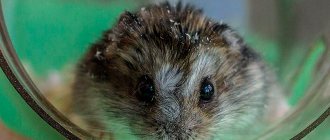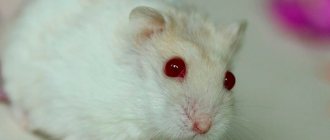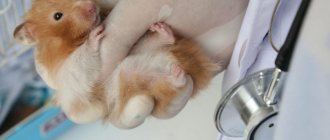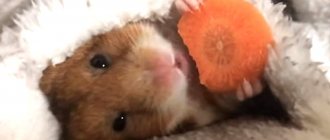Home » Hamsters » A hamster’s eye does not open and is festering - what to do
Hamsters have good health and rarely make their owners worry about their pet's poor health. However, such animals also get sick. Sometimes owners experience that their eyes stick together. The article will tell you why this happens and how you can help if the hamster’s eyes do not open.
Why does a hamster's eye not open or fester?
Almost always, eye problems in a pet are associated with disease and inflammation. They occur under improper conditions of detention, due to injuries, reduced immunity, etc. In rare cases, the animal’s eyes do not open due to an allergic reaction. This can be considered a relatively harmless reason, since it can be easily eliminated without causing harm to the pet’s health.
Allergic reaction
An allergy is an incorrect reaction of the body to substances that come into contact with cells of the immune system. Disruption of the latter is the cause of intolerance. The disease may be accompanied by redness of the skin, itching, nausea and vomiting, etc.
The pathology is more common in Djungarians, although it can occur in representatives of any breed.
If your hamster has a watery eye or swollen eyelids, you should suspect intolerance. In advanced cases, the animal independently damages the mucous membrane due to itching, which can lead to the development of conjunctivitis.
Unsanitary conditions
Unsanitary conditions pose a danger to your pet due to the high risk of infection. Against the backdrop of rare cleanings, active proliferation of microbes begins in the filler.
Regular cage cleaning will prevent the development of eye diseases in hamsters.
The delicate mucous membranes and immune system of the animal cease to cope with the excess of pathogens. As a result, owners are faced with problems such as red eyes in the pet, inflammation, purulent discharge, etc.
Veterinarians recommend cleaning 2-3 times a month so as not to cause stress in your pet and at the same time prevent infection.
Injuries and wounds
A hamster may accidentally injure itself. For example, getting out of a cage and falling or colliding with a sharp object. Animals often damage their mucous membranes due to litter or food particles.
If living together is not organized correctly or the level of stress is high, pets can fight and injure each other.
If the owner witnesses a fight between rodents, he needs to examine the pets and monitor their condition for several days. The wound may not become inflamed immediately. If there is even minor damage in the area of the visual organs, treatment should begin immediately, without waiting for symptoms to appear.
With a fresh wound, swelling and redness can be detected. The eye waters, hurts, and causes discomfort to the animal. An injured hamster hides and tries to spend more time in hiding. He moves little and sleeps more often. If left untreated, the damaged area may become infected. In this case, conjunctivitis develops.
Animals can injure their eyes in a fight.
Reduced immunity
The deterioration of the immune system in itself is not the reason why the eye may become watery or swollen. However, against this background, the development of other pathologies, including the organs of vision, is facilitated. Decreased immunity can be associated both with improper conditions of detention and with concomitant diseases. For example, lesions of the gastrointestinal tract. Even stress and bathing can trigger disruptions in the immune system.
Why is conjunctivitis dangerous?
Conjunctivitis for hamsters is not at all the same as for humans. If a person can cope with this problem in a few days with the help of eye drops, then your pet does not have the opportunity to overcome the disease on its own. For this reason, you need to be wary if you notice at least one of the signs of conjunctivitis. It is worth considering that conjunctivitis, as a rule, is the very beginning of the pathology. Without taking appropriate measures, conjunctivitis will quickly turn into keratitis, followed by ulceration of the cornea of the eye. If a hamster's eye is swollen, but the owner does not pay any attention to it for a long time, then the rodent may go blind and then die.
The same dangers await the pets of their owners, who not only do not pay attention to the problem, but treat the pet incorrectly.
Under no circumstances should you self-prescribe pills to your pet or, even worse, give injections. This should only be done by an experienced veterinarian.
If you prevent your hamster from getting sick or detect it in time, you won’t have to think about why your hamster’s eye popped out and how to help him in such a situation. Often, due to late detection of the disease, pets completely lose their vision.
Injuries and inflammatory processes and their symptoms
In inflammatory processes associated with pathologies or injuries, the following symptoms occur:
- edema;
- inability to open eyes, squinting, trembling eyelids;
- liquid or purulent discharge, tearing;
- formation of a cone or barley;
- redness of the damaged area;
- hair loss on the eyelids and around the eyes.
The presence of these manifestations indicates infectious or age-related pathologies, and sometimes mechanical damage. In the latter case, infection with pathogens may occur later if the animal was not treated in time or the pet’s immune system is weakened.
When infected, the general condition further worsens. The pet refuses water and food, vomits, and digestion of food is disrupted.
Corneal damage
Damage to the cornea occurs more often in mobile, active animals. In most cases, the condition is associated with mechanical trauma.
Corneal damage often occurs due to mechanical trauma.
Shards, dust, sand, filler, etc. can get into your eyes. Sometimes the damage is caused by a scratch. In rare cases, the integrity of the cornea is compromised due to infectious pathologies, contact with chemicals and congenital pathologies.
If the pet's cornea is damaged, visual acuity decreases. The problematic eye is closed or squinted, the eyelids tremble. Sensitivity to irritants is increased: the pet hides in a bright room and suffers from severe lacrimation. The general well-being of the animal worsens. The mucous membranes turn red.
If damage to the cornea is associated with a foreign object, there is a chance that the latter will be removed without third-party intervention along with the discharge. Otherwise, you need to visit a veterinarian. After removing foreign bodies, the eyelids are washed with antibacterial agents and anti-inflammatory drugs are used.
Blepharitis
Blepharitis is an inflammatory process that primarily affects the eyelid rather than the eye. However, these are neighboring tissues, so as the disease develops, the organs of vision also suffer. Blepharitis develops due to many reasons. For example, due to bacterial infections, incorrect use of medications, inflammatory dermatological pathologies, gastrointestinal problems, etc.
Blepharitis is accompanied by purulent inflammation of the eyelids.
Blepharitis is characterized by changes in the color of the eyelids. They may darken, but more often they turn red due to inflammation. Sometimes the skin on them peels off. The animal suffers from itching. It scratches your eyes and can damage them. Another problem is weakening of local immunity and possible infection. Bumps often form on inflamed eyelids.
Blepharitis of the eye is usually treated with antibiotics. Additionally, it is important to maintain cleanliness in the cage and provide your pet with time. This will prevent the progression of the disease and infection of the tissues.
Abscess
Another name for an abscess is stye. This is not an independent disease, but a symptom. It can occur against the background of blepharitis, weakened immunity with concomitant infection, etc. When an abscess appears, the appearance of the eye changes, and a difference in size becomes visible due to the tumor. The temperature of neighboring tissues rises as a result of inflammation.
With an abscess, itching occurs, and sometimes mucous discharge appears. In rare cases, barley goes away on its own, but more often it requires veterinary intervention. Recovery occurs after the capsule is freed from pus.
Blunt trauma
A rodent can receive blunt trauma as a result of a fall. Sometimes an animal is accidentally crushed while walking. As a result, massive damage to all structures of the visual organs occurs. It is accompanied by severe hemorrhage. In case of injury, only 1 eye or both may be affected. A few hours after the injury occurs, the blood settles and the tissues turn red. The entry of blood particles into the vitreous body causes vision loss.
In case of injury, damage to one eye is typical.
If a blunt injury occurs, the animal should be taken to a veterinarian as quickly as possible. It is impossible to make a prognosis and cure your pet at home on your own. You can only provide first aid if you cannot visit the clinic in the near future. Apply a cool cloth soaked in saline solution to the damaged area and use antibacterial ointment. The latter prevents the cornea from drying out in case of severe swelling, if the animal cannot blink.
Conjunctivitis
Conjunctivitis is the most common eye disease found in hamsters. The pathology is characterized by bilateral inflammation, although this is an optional sign. The disease develops due to mechanical trauma, irritation from chemicals, infections, allergies, etc. The animal can become ill when in contact with household products, such as floor cleaning solution or hairspray. Filler, dust or sand can provoke inflammation. Poor quality litter injures mucous membranes.
With conjunctivitis, the animal's eyes begin to water.
Symptoms help indirectly determine the cause. In the initial stages, if the disease is caused by mechanical irritation or allergies, the discharge from the eyes will be clear. If there is an infection, the liquid becomes cloudy and later acquires a yellow or greenish tint. The animal can become infected with pathogens during the process if it is not given timely assistance.
Other symptoms include itching, pain, photophobia and watery eyes. The eyeball enlarges, the eyelids swell. To eliminate symptoms, anti-inflammatory and antibacterial agents are used.
Bacterial infections
Bacterial infection can be either an independent or concomitant disease. Most often, conjunctivitis develops as a result of the penetration of pathogens. An animal can become infected if it has a weakened immune system, is injured, has a damaged cornea, etc.
Bacteria multiply quickly, especially if the damage is deep. Without help, pathogens increasingly penetrate tissues. Subsequently, the bacteria, along with the bloodstream, are spread to all organs and systems, which can lead to the death of the animal. In case of deep infection, it is necessary to resort to surgical intervention, including removal of the eye, in order to save the hamster’s life.
Eye diseases associated with aging changes in the body
Very often, with age, hamsters develop such an unpleasant disease as cataracts. It manifests itself as white spots, clouding of the lens, and blurred vision. The animal gets really stressed because it begins to see poorly. Unfortunately, this disease can rarely be cured; all that remains is to make the animal’s life as easy as possible by following certain tips:
- Do not place the hamster's cage in direct sunlight, this will further irritate the eyes and worsen the situation;
- Don't give your animal a lot of sweets. In return, give a lot of carrots and zucchini.
- Do not place many objects in the cage, because due to poor eyesight the animal may hit them and injure itself.
This is all you can do for your pet to somehow make his life easier.
How to treat inflammatory eye diseases
In case of inflammatory diseases, they try to provide rest to the animal. Rinsing is carried out to prevent eyelid sticking, infection and increased discomfort. If the eye is already infected with pathogens, the procedure prevents bacteria from further penetrating into the deeper tissues.
The filler must be removed from the cage. It is replaced with paper towels. All accessories are disinfected with hot water and soap. The cage is placed in a dark place.
Choice of medications
The choice of medications depends on the nature of the pathology. Anti-inflammatory drugs are most often used. The most neutral drug is saline solution. It is used to wash and moisturize the eyes. It does not cause tissue drying, and therefore does not contribute to further infection.
In most cases, antibiotics are included in the treatment regimen, even if there are no signs of bacterial infection. This prevents infection due to weakened immunity.
Preference is given to local drugs, since generic ones are ineffective.
If necessary, the discharge is removed with a soft sterile swab soaked in saline solution. For infection, use Furacilin. If there is no improvement within 2-3 days, use Tobrex or Floxal drops. If necessary, take a long break between washes and add ointment.
Drops for the treatment of inflammatory eye diseases in hamsters.
Cleaning your eyes at home
The eyes are washed with saline solution, weak tea leaves, chamomile infusion or Furacilin. To do this, take a soft swab or cotton swab, moisten it in the product and carefully move it from the corner of the eye towards the outside. You can't go against the grain when eliminating discharge. This will cause dirt to get into deep tissues. Do not press on the skin. This traumatizes the pet. A separate swab is used for each eye.
Diet restrictions
The menu during illness is strictly limited. The pet is fed mainly grain crops, and animal proteins are given in small portions. Diet diversity is avoided due to weakened immunity and the need to reduce the load on the gastrointestinal tract.
Providing first aid to a sick hamster
Timely provision of first aid to a sick animal is extremely important:
- The pet is given complete rest and is not disturbed unless unnecessary.
- In some cases, it is possible to remove foreign objects and debris from the animal’s eyes. To do this, experienced breeders use a small syringe and warm saline solution.
- If an allergy is suspected, your pet can be given a couple of drops of Zyrtec or a similar drug. Diphenhydramine and other medications in tablet form should not be given, as dosing problems may arise.
Treatment for droopy eyes
If an animal's eyes are stuck together, you should not try to forcefully separate the eyelids - this will lead to injury. In this case, rinsing is carried out, but the crusts are generously moistened with a medicinal agent. After this, they soften and become easier to remove.
To eliminate eye stickiness, you should clean your eyelids with saline solution.
Preventive measures
Agree, it is better to prevent any disease in domestic hamsters than to treat it later. And for this you need to create the necessary conditions for your pet. Considering the causes of such diseases, caring owners should:
- Use cage mats specifically designed for hamsters. Such material should not contain piercing or cutting objects, as well as a lot of dust.
- You should not keep a large number of rodents in one cage. They can injure each other, which will result in various diseases, including eye diseases.
- Genetically predisposed individuals must be immediately excluded from the general “herd.” Such hamsters can be a carrier of an infection from birth, transmitted to them from their mother or father.
- During the keeping process, the cage with rodents must be placed in a bright place, but protected from the sun. Direct exposure to sunlight and ultraviolet radiation negatively affects the health of pets.
- Regular examination of animals will help you at an early stage to identify not only carriers of diseases, but also to prevent the development of an already established disease in hamsters.
Non-inflammatory diseases
Non-inflammatory diseases include cataracts, cataracts, glaucoma and oncological pathologies. Some of them are related to genetics or age-related changes. In general, such pathologies progress more slowly, making it more difficult for owners to notice the symptoms.
Belmo
A cataract is characterized by the appearance of a white spot on the surface of the eye. The cause of the disease is trauma, and less commonly, cataracts. With massive damage, the stain can cover the entire surface. If some of the mucous membranes turn white, you need to contact a veterinarian. This will help distinguish the eyesore from other pathologies. The disease has no cure, but does not threaten the life of the hamster. The animal's vision may deteriorate.
An eyesore is caused by injury or cataracts.
Cataract
Cataracts in a hamster develop due to a metabolic failure in the lens. If the disease progresses, it leads to blindness. It is assumed that the pathology develops due to injuries, old age, frequent stress, etc.
Cataracts in rodents cannot be treated. Surgical intervention is not used for pathology, and eye drops are ineffective. The disease is easier to prevent than to cure. To do this, the pet is fed plant foods rich in retinol, is not given sweets, vision pathologies are promptly eliminated, and the cage is not placed in the sun.
Glaucoma
Glaucoma is characterized by increased eye pressure. Because of it, the tissues increase in size and begin to bulge. The pet is in pain. Without help, the eyes fall out or leak. The only thing a veterinarian can do in this case is to perform enucleation. The animal will lose vision, but the procedure will prevent infection and relieve pain.
Glaucoma causes increased intraocular pressure and is accompanied by bulging of the eyeballs.
Oncological diseases
A lump in the eye area may not be blepharitis, but a malignant tumor. There is no generally accepted effective treatment in this case, but you can try to save your pet. To do this, they turn to a ratologist to remove the tumor, after the operation they use antibiotics, drugs to strengthen the immune system and vitamins. Even if the treatment does not save the animal, it will improve its condition.
Blepharitis
This disease may be a consequence of advanced conjunctivitis. In this case, the inflamed eyelid sticks together, and the inflammatory process spreads deeper and deeper inside. At an advanced stage, both organs of vision may be closed. This disease is accompanied by redness and swelling of the eyelids.
What to do in this case? This disease can be treated if you consult a veterinarian in time. Often the treatment regimen is identical to the treatment regimen for conjunctivitis. Often, special eye drops are used in the treatment of this disease, for example Tsiprovet or Floxal, as well as additionally tetracycline ointment.
With this disease, the hamster should be put on a diet and the cage should be disinfected.
Temperature-related disorders
If a previously healthy animal suddenly falls into a coma, it is possible that it is hibernating. Breathing will be very rare, and the pet will be cold to the touch. In nature, dwarfs hibernate in winter, waiting out cold, hunger and short daylight hours.
Low room temperature
If the heating was turned off in the apartment, or you did not feed the hamster for several days while going on vacation, this could provoke torpor. The body will be cold, the heartbeat will be extremely rare (1 beat every 15 seconds). A sleeping hamster can barely breathe; due to its small size, it is difficult to understand whether there is breathing at all. But if the body remains soft, the rodent has not died. To awaken the animal, the cage is placed in a warm room (more than 20 C), the feeder and drinking bowl are filled. The hamster should wake up in 2-3 days.
Heat
The Djungarian hamster lives in the steppes, and the Syrian even in semi-deserts, but both species are extremely sensitive to high temperatures and direct sunlight. Tiny nocturnal rodents with dense fur have no protection from overheating - they do not sweat or breathe through their mouths like dogs. Heat stroke is deadly for them.
Signs of hyperthermia:
- the hamster does not move and is breathing heavily;
- weakness;
- convulsions;
- impaired coordination of movements.
In case of acute overheating, heart failure leads to the death of the pet. Death may not occur immediately, but within a couple of days due to the failure of all organs, if the temperature has risen so much that proteins have coagulated in the blood and organs (at 44 C).
Situations in which there is a danger of heat stroke:
- transportation in a car;
- a cage on a windowsill or balcony, outside (sun);
- near heating devices;
- in a stuffy room with high humidity.
It can be difficult to understand why a hamster is lying on its side and breathing heavily if by the time the owner returns the sun has already gone and does not illuminate the cage.
Treatment for heat or sunstroke
Transporting a pet to a clinic in case of heat or sunstroke is not the best solution; time for first aid will be missed. What can you do without the help of a veterinarian to help your pet:
Reduce temperature
First aid is to cool the body, but not too sharply: applying ice or immersing the hamster in water is prohibited! The animal is placed on a tile or ceramic dish, or on a damp towel. Gently wet ears and paws with cool water.
Fighting dehydration
Heat stroke very often occurs when there is no access to fresh drinking water. When the animal is unconscious, it can no longer use the drinking bowl. However, it is also dangerous to drink a hamster from a syringe: it will not swallow, and the liquid will enter the lungs, making breathing difficult and causing pneumonia.
The liquid (sterile Ringer's solution or sodium chloride) is injected subcutaneously into 4-8 ml of Syrian and 2 ml of Djungarian hamsters.
Antishock therapy
Although all potent medications are best used as prescribed by a doctor, in a situation with acute overheating, the hamster may not survive to take the ratologist. If you feel like you have nothing to lose, you should inject prednisolone 30 mg/ml intramuscularly (in the hind leg) with an insulin syringe. The dose for a Dzhungarik is 0.05 ml, for a Syrian - 0.1 ml.
The prognosis is unfavorable: the pet may die
Whether your pet survives may depend on how long it was exposed to the high temperature. If the hamster does not die immediately, on the first day after overheating the owner often notices that the hamster falls over on its side and can barely walk. Neurological disorders are associated with swelling of the brain, and if the pet survives, coordination of movements will gradually be restored.











